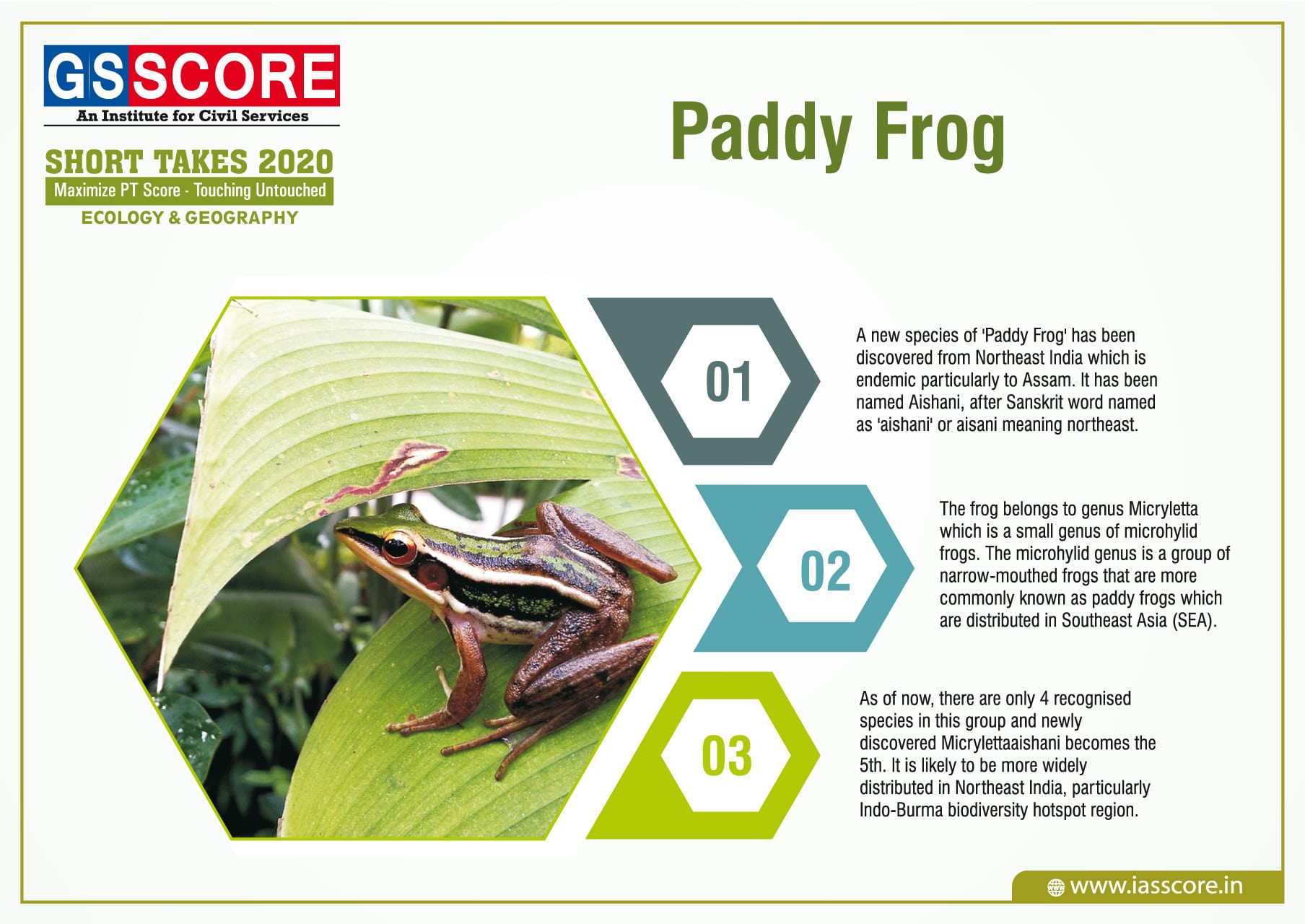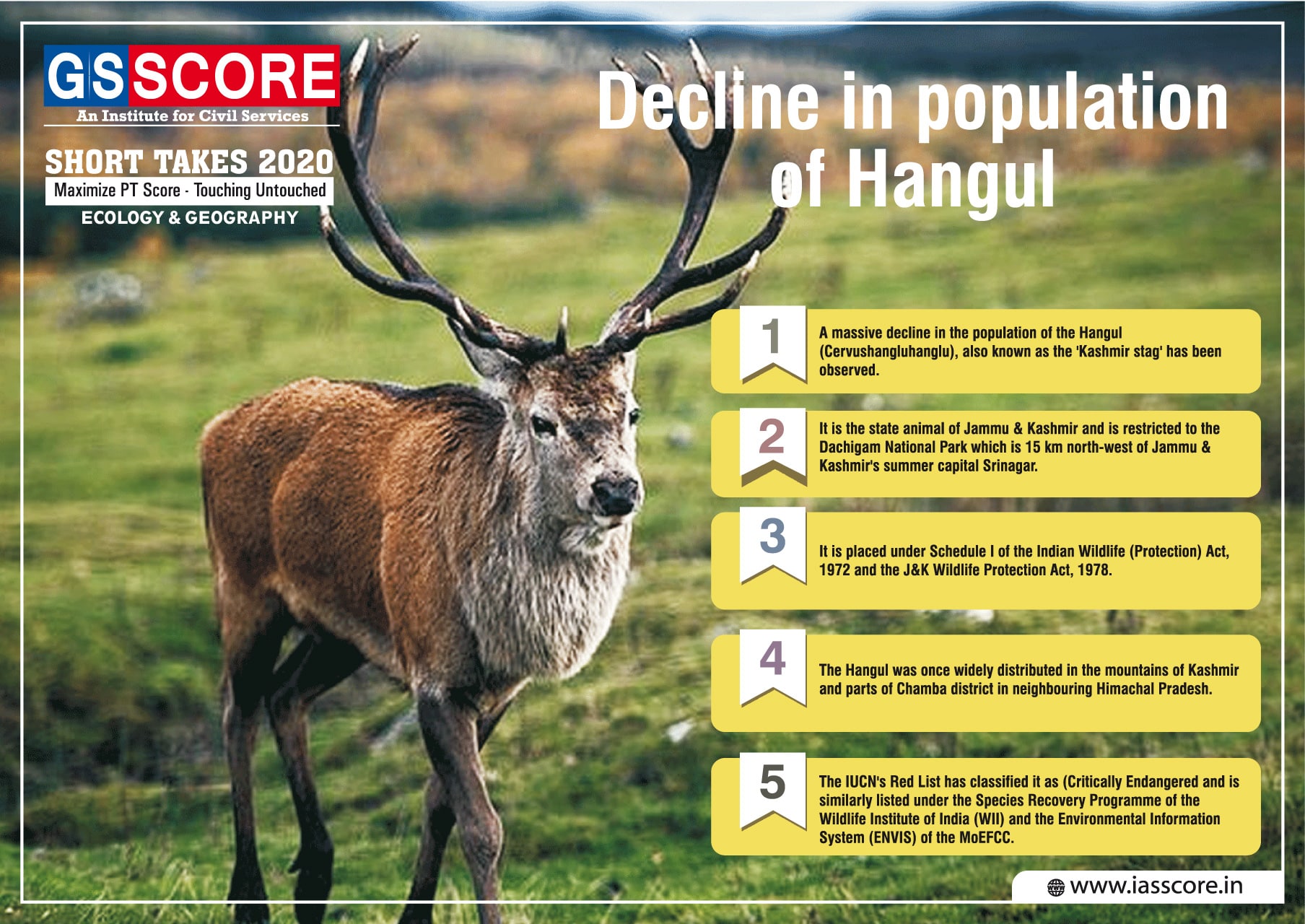Science & Technology: International Organisations and their Programmes
International Missions
1. International Space Station
- The International Space Station (ISS) is a space station (habitable artificial satellite) in low Earth orbit.
- The ISS programme is a joint project between five participating space agencies: NASA (United States), Roscosmos (Russia), JAXA (Japan), ESA (Europe), and CSA (Canada).
- The ownership and use of the space station is established by intergovernmental treaties and agreements.
- The ISS serves as a microgravity and space environment research laboratory in which crew members conduct experiments in biology, human biology, physics, astronomy, meteorology, and other fields.
- The station is suited for the testing of spacecraft systems and equipment required for missions to the Moon and Mars.
- The ISS maintains an orbit with an average altitude of 400 kilometres (250 mi) by means of reboost manoeuvres using the engines of the Zvezda module or visiting spacecraft. It circles the Earth in roughly 92 minutes and completes 15.5 orbits per day.
2. Hubble Space Telescope
- The Hubble Space Telescope (often referred to as HST or Hubble) is a space telescope that was launched into low Earth orbit in 1990 and remains in operation.
- It was not the first space telescope but it is one of the largest and most versatile, well known both as a vital research tool and as a public relations boon for astronomy.
- The Hubble telescope is named after astronomer Edwin Hubble and is one of NASA's Great Observatories, along with the Compton Gamma Ray Observatory, the Chandra X-ray Observatory, and the Spitzer Space Telescope.
- Hubble features a 2.4-meter (7.9 ft) mirror, and its four main instruments observe in the ultraviolet, visible, and near infrared regions of the electromagnetic spectrum.
- Hubble's orbit outside the distortion of Earth's atmosphere allows it to capture extremely high-resolution images with substantially lower background light than ground-based telescopes.
- It has recorded some of the most detailed visible light images, allowing a deep view into space.
- Many Hubble observations have led to breakthroughs in astrophysics, such as determining the rate of expansion of the universe.
- The Hubble telescope was built by the United States space agency NASA with contributions from the European Space Agency.
- The Space Telescope Science Institute (STScI) selects Hubble's targets and processes the resulting data, while the Goddard Space Flight Center controls the spacecraft.
- Space telescopes were proposed as early as 1923.
- Hubble was funded in the 1970s with a proposed launch in 1983, but the project was beset by technical delays, budget problems, and the 1986 Challenger disaster.
- It was finally launched by Space Shuttle Discovery in 1990, but its main mirror had been ground incorrectly, resulting in spherical aberration that compromised the telescope's capabilities.
- The optics were corrected to their intended quality by a servicing mission in 1993.
3. Juno: Mission at Jupiter
- Juno is a NASA space probe orbiting the planet Jupiter.
- It was built by Lockheed Martin and is operated by NASA's Jet Propulsion Laboratory.
- The spacecraft was launched from Cape Canaveral Air Force Station on August 5, 2011 (UTC), as part of the New Frontiers program.
- Juno entered a polar orbit of Jupiter on July 5, 2016, to begin a scientific investigation of the planet.
- After completing its mission, Juno will be intentionally deorbited into Jupiter's atmosphere.
- Juno's mission is to measure Jupiter's composition, gravity field, magnetic field, and polar magnetosphere.
- It will also search for clues about how the planet formed, including whether it has a rocky core, the amount of water present within the deep atmosphere, mass distribution, and its deep winds, which can reach speeds up to 618 kilometres per hour (384 mph).
- Juno is the second spacecraft to orbit Jupiter, after the nuclear powered Galileo orbiter, which orbited from 1995 to 2003.
- Unlike all earlier spacecraft sent to the outer planets, Juno is powered by solar arrays, commonly used by satellites orbiting Earth and working in the inner Solar System, whereas radioisotope thermoelectric generators are commonly used for missions to the outer Solar System and beyond.
- For Juno, however, the three largest solar array wings ever deployed on a planetary probe play an integral role in stabilizing the spacecraft as well as generating power.
4. Artemis Program
- The Artemis program is an ongoing crewed spaceflight program carried out predominantly by NASA, U.S. commercial spaceflight companies, and international partners such as the European Space Agency (ESA), the Japan Aerospace Exploration Agency (JAXA), Canadian Space Agency (CSA) and the Australian Space Agency (ASA) with the goal of landing "the first woman and the next man" on the Moon, specifically at the lunar south pole region by 2024.
- NASA sees Artemis as the next step towards the long-term goal of establishing a sustainable presence on the Moon, laying the foundation for private companies to build a lunar economy, and eventually sending humans to Mars.
- In December 2017, Space Policy Directive was signed authorizing the lunar campaign.
- Artemis draws upon ongoing spacecraft programs including Orion, the Lunar Gateway, and Commercial Lunar Payload Services, and adds an undeveloped crewed lander.
- The Space Launch System will serve as the primary launch vehicle for Orion, while commercial launch vehicles are planned for use to launch various other elements of the campaign.
5. BepiColombo
- BepiColombo is a joint mission of the European Space Agency (ESA) and the Japan Aerospace Exploration Agency (JAXA) to the planet Mercury.
- The mission comprises two satellites launched together: the Mercury Planetary Orbiter (MPO) and Mio (Mercury Magnetospheric Orbiter, MMO).
- The mission will perform a comprehensive study of Mercury, including characterization of its magnetic field, magnetosphere, and both interior and surface structure.
- It was launched on an Ariane 5 rocket on 20 October 2018, with an arrival at Mercury planned for December 2025, after a flyby of Earth, two flybys of Venus, and six flybys of Mercury.
- The mission was approved in November 2009, after years in proposal and planning as part of the European Space Agency's Horizon 2000+ programme; it is the last mission of the programme to be launched.
Objectives
The main objectives of the mission are:
- Study the origin and evolution of a planet close to its parent star
- Study Mercury's form, interior, structure, geology, composition and craters
- Investigate Mercury's exosphere, composition and dynamics, including generation and escape
- Study Mercury's magnetised envelope (magnetosphere) - structure and dynamics
- Investigate the origin of Mercury's magnetic field
- Verify Einstein's theory of general relativity by measuring the parameters gamma and beta of the parameterized post-Newtonian formalism with high accuracy
6. Habitable Zone Planet Finder
- A new astronomical spectrograph built by a Penn State-led team of scientists provides the highest precision measurements to date of infrared signals from nearby stars, allowing astronomers to detect planets capable of having liquid water on their surfaces that orbit cool stars outside our Solar System.
- The Habitable Zone Planet Finder (HPF) allows precise measurement of a star's radial velocity, measured by the subtle change in the color of the star's spectra as it is tugged by an orbiting planet, which is critical information in the discovery and confirmation of new planets.
- The HPF, located at McDonald Observatory at the University of Texas at Austin, targets low-mass planets around cool nearby M dwarf stars in Habitable Zones, regions where liquid water might exist on a planet's surface.
- M dwarf stars are known to host rocky planets, but these stars are faint due to their size and their magnetic activity manifests as spots and flares, which pose problems for existing visible light instruments.
- The HPF, coupled to the 10-meter Hobby Eberly Telescope, instead uses near-infrared light a type of invisible infrared light closest in wavelength to the visible spectrum -- to observe these stars at wavelengths where they are brighter and less active.
7. Perseverance
- NASA's Perseverance mission will send an advanced roving laboratory to Jezero crater on Mars, the site of an ancient lake and river delta.
- There, the rover will study rocks that formed in habitable environments and may preserve signs of past microbial life.
- Throughout the mission, it will collect soil and rock samples and leave them on the surface for collection by a future Earth return mission.
- Only when the samples are returned to Earth will scientists be able to determine whether definitive signs of ancient life are present.
- Perseverance is similar in structure and appearance to NASA's Curiosity rover.
- The components it will use to land on Mars are nearly identical to those used for Curiosity, but there are some upgrades, and the science instruments are entirely different.
- The Planetary Society is an education and public outreach partner for the Mastcam-Z camera system, which will produce stunning color images of the surface.
8. Chang'e-4
- China's Chang'e-4 mission delivered a landing platform and a rover named Yutu-2 to the Moon's far side—the first mission there by any country.
- Chang'e-4 landed in Von Kármán crater, within the Moon's South Pole-Aitken basin, in December 2018.
- An ancient lunar impact there may have exposed the Moon’s mantle.
- By studying this region directly, scientists will learn more about the early solar system and Earth.
- The mission also demonstrates the feasibility of future human and robotic far side missions.
- The Moon’s quiet, airless far side makes it one of the best places in the inner solar system for science applications like radio astronomy.
- But missions there require a relay satellite, since the far side never faces Earth.
- China launched the Queqiao relay satellite with two SmallSats, Longjiang-1 and 2, in May 2018.
- Chang’e-4 and Yutu-2 are continuing to conduct science operations.
- Both vehicles power down during the 2-week lunar night, when temperatures plummet to -173 degrees Celsius (280 degrees Fahrenheit), to avoid damanging their instruments.
- They must also sleep when the Sun is directly overhead to avoid overheating.
9. OSIRIS-Rex
- OSIRIS-REx is a mission to retrieve a sample from near-Earth asteroid 101955 Bennu.
- By returning pristine carbon-bearing rocky material from the surface of an asteroid, the science team seeks to understand how primitive asteroids contributed to the origin of planets, and what role they may have played in the origin of life on Earth.
- The mission will map Bennu and its composition in 3D and ground-truth earlier astronomical surveys.
- It will also study how Bennu’s orbit changes when it gets heated by sunlight and radiates the heat away in a different direction at night, a phenomenon known as the Yarkovsky effect.
Past milestones
25 May 2011: NASA selects OSIRIS-REx as next New Frontiers mission, The Planetary Society will participate in a contest to name target asteroid 1999 RQ38 August 2019: OSIRIS-REx enters 1.7-kilometer-altitude orbit, beginning Orbital C phase
12 June 2019: OSIRIS-REx enters 680-meter-altitude orbit, beginning Orbital B phase
22 April 2019: OSIRIS-REx begins Detailed Survey: Equatorial Stations phase (PDF diagram)
28 February 2019: OSIRIS-REx completes Orbital A phase, moves on to Detailed Survey: Baseball Diamond phase (PDF diagram)
19 January 2019: OSIRIS-REx observes Bennu to be an active asteroid
31 December 2018: OSIRIS-REx enters 2,000-meter-altitude orbit, ending Preliminary Survey phase and beginning Orbital A phase
10 December 2018: OSIRIS-REx finds water on Bennu
3 December 2018: Bennu arrival, beginning Preliminary Survey phase (PDF diagram)
16 November 2018: TAGSAM successfully tested
17 August 2018: OSIRIS-REx sees Bennu from a distance of 2.2 million kilometers
22 September 2017: Earth flyby; read Vicky Hamilton’s article for The Planetary Report on how the flyby tested OSIRIS-REx’s instruments
8 September 2016: Launch
20 May 2016: OSIRIS-REx ships to Cape Canaveral, Florida
5 June 2014: Construction begins
1 May 2013: The Planetary Society announces naming contest results; 1999 RQ3 will be named after Egyptian god Bennu
“Betelgeuse Supernova”
Context
Betelgeuse, the red supergiant star that marks the armpit of Orion the Hunter, has been dramatically and mysteriously dimming for the last six months.
About:
Betelgeuse is a red supergiant star, located an estimated 642 light-years
Location: It’s usually the 11th brightest star in the sky, taking its position as the right shoulder of Orion. But in the last few months, it’s dimmed down to 38% of its usual brightness, now the 24th brightest star in the sky.
- Variable star: Variations are normal for Betelgeuse, and it’s known to get dimmer and brighter. It’s literally growing and shrinking as the internal temperatures rise and fall pushing the star in and out like a beating heart.
- Convective cells: It has enormous convective cells on its surface that boil creating brighter and dimmer regions, and it’s constantly blowing out dust that can obscure our view for a time.
What’s the reason behind this?
- Astronomers have captured the unprecedented dimming of Betelgeuse Using ESO’s Very Large Telescope (VLT).
- The stunning new images of the star’s surface show not only the fading red supergiant but also how its apparent shape is changing.
- The red supergiant Betelgeuse has recently dimmed quite dramatically because those two periodic cycles are overlapping at minimal brightness.
- Beginning in October 2019, astronomers noticed that the brightness of Betelgeuse suddenly began to change. The star was dimming.
- Once one of the top 10 brightest stars in the sky, its brightness had fallen to 21st place by the end of December 2019.
Is it going to explode?
- Astronomers have long suspected that the star might explode sometime in the next million years.
- It's also possible that Betelgeuse has already exploded and we just haven't seen it happen; because the star is 600 light-years away, it takes 600 years after something happens on Betelgeuse for light from that event to reach Earth.
- But if and when astronomers do witness the star's explosion, it will be the most astonishing astronomy event of all time.
- When Betelgeuse explodes, turning into a supernova, it will briefly shine even brighter than the full moon. Then, the star will vanish forever.
What is The Very Large Telescope array (VLT)?
- The Very Large Telescope array (VLT)is the flagship facility for European ground-based astronomy at the beginning of the third Millennium.
- It is the world's most advanced optical instrument, consisting of four Unit Telescopes with main mirrors of 8.2m diameter and four movable 1.8m diameter Auxiliary Telescopes.
- The telescopes can work together, to form a giant ‘interferometer’, the ESO Very Large Telescope Interferometer, allowing astronomers to see details up to 25 times finer than with the individual telescopes.
- The light beams are combined in the VLTI using a complex system of mirrors in underground tunnels where the light paths must be kept equal to distances less than 1/1000 mm over a hundred metres.
- With this kind of precision, the VLTI can reconstruct images with an angular resolution of milliarcseconds, equivalent to distinguishing the two headlights of a car at the distance of the Moon.
- The 8.2m diameter Unit Telescopes can also be used individually.
- With one such telescope, images of celestial objects as faint as magnitude 30 can be obtained in a one-hour exposure.
- This corresponds to seeing objects that are four billion (four thousand million) times fainter than what can be seen with the unaided eye.
Over their lifetimes, red supergiants (like Betelgeuse) create and eject vast amounts of material even before they explode as supernovae. Today’s modern technology has enabled scientists to study these objects, hundreds of light-years away, in unprecedented detail. It gives the opportunity to unravel the mystery of what triggers their mass loss.
“SyRI (System Risk Indicator)”
Context
In a first anywhere in the world, a court in the Netherlands recently stopped a digital identification scheme for reasons of exclusion. This has a context for similar artificial intelligence systems worldwide, especially at a time when identity, citizenship and privacy are pertinent questions in India.
What was the scheme?
- SyRI (System Risk Indicator) is an identification mechanism.
- The Dutch Ministry of Social Affairs developed SyRI in 2014 to weed out those who are most likely to commit fraud and receive government benefits.
- Legislation passed by the Dutch Parliament allowed government agencies to share 17 categories of data about welfare recipients such as taxes, land registries, employment records, and vehicle registrations with a private company.
- The company, called “The Intelligence Agency”, used an algorithm to analyse data for four cities and calculate risk scores.
- The selective rollout was conducted in low-income and immigrant neighbourhoods, which have a higher number of beneficiaries.
- Elevated risk scores were sent to relevant government arms, which stores these on government databases for a maximum of two years.
- The government, in that time period, could open an investigation on the targeted person.
The issue:
- Recently, a Dutch district court ruled against SyRI (System Risk Indicator), because of data privacy and human rights concerns.
- While the Hague district court found using new technology to control fraud was acceptable, it held SyRI was too invasive and violative of the privacy guarantees given by European Human Rights Law as well as the EU’s General Data Protection Regulation.
- Legal criticism alleged that the algorithm would begin associating poverty and immigrant statuses with fraud risk.
- The court found that opaque algorithmic decision-making puts citizens at a disadvantage to challenge the resulting risk scores. The Netherlands continuously ranks high on democracy indices.
- The court ruled that SyRI was violative of principles of transparency and data minimisation laid out in their General Data Protection Regulation.
- Other European tech initiatives have been stalled by the regulation, including a facial recognition system on students in Sweden and France.
How relevant is this for India?
- Similar to the Supreme Court’s Aadhaar judgment setting limits on the ID’s usage, The Hague Court attempted to balance social interest with personal privacy.
- However, the Aadhaar judgment was not regarding algorithmic decision-making; it was about data collection.
- The ruling is also an example of how a data protection regulation can be used against government surveillance.
- India’s pending data protection regulation, being analysed by a Joint Select Committee in Parliament, would give broad exemptions to government data processing in its current form.
Similar regulations by the US:
- India’s proposed regulation is similar to the US in the loopholes that could be potentially exploited.
- Hence, attempts to ban facial recognition in cities such as San Francisco have not had the same success as attempts in Europe.
- A system somewhat paralleling the Dutch SyRI system was a risk-scoring software being used by US court systems to establish bail times.
- The US Supreme Court declined to hear a related case in 2017.
Global countries taking note of the ‘ruling’:
- Digital ID systems are being rolled out at a fast pace in places like Kenya, Philippines, Nigeria, Mexico, and more.
- Experts worldwide have been watching the Netherlands case throughout, and agree that the ruling will ripple beyond south Rotterdam.
The ruling sets a strong legal precedent for other nations to follow. This is one of the first times a court has stopped the use of digital technologies and abundant digital information on human rights grounds.
“Genome India Project”
Context
The government has cleared an ambitious gene-mapping project that is being described by those involved as the “first scratching of the surface of the vast genetic diversity of India”.
What is a genome?
- Every organism’s genetic code is contained in its Deoxyribose Nucleic Acid (DNA), the building blocks of life.
- A genome, simply put, is all the genetic matter in an organism. It is defined as “an organism’s complete set of DNA, including all of its genes.
- Each genome contains all of the information needed to build and maintain that organism. In humans, a copy of the entire genome, more than 3 billion DNA base pairs, is contained in all cells that have a nucleus
- The discovery that DNA is structured as a “double helix” by James Watson and Francis Crick in 1953, for which they won a Nobel Prize in 1962, was the spark in the long, continuing quest for understanding how genes dictate life, its traits, and what causes diseases.
About
About the Project:
- The first stage of the project will look at samples of “10,000 persons from all over the country” to form a “grid” that will enable the development of a “reference genome”.
- Nodal agency: The IISc’s Centre for Brain Research, an autonomous institute, will serve as the nodal point of the project.
- Aim: Its aim is to ultimately build a grid of the Indian “reference genome”, to understand fully the type and nature of diseases and traits that comprise the diverse Indian population.
Benefits of the Project:
The Genome India Project, a collaboration of 20 institutions will enable new efficiencies in medicine, agriculture and the life sciences. The major benefits are as given below:
- Improving health: Several diseases develop through metabolic polymorphisms. If such propensities to disease can be mapped to variations across genomes, it is believed public health interventions can be targeted better, and diseases anticipated before they develop.
- Agriculture: A better understanding of the genetic basis of susceptibility to blights, rusts and pests can make it possible to deter them genetically, and reduce dependence on chemicals.
- Mapping the diverse gene pools: Global science would also benefit from a mapping project in one of the world’s most diverse gene pools, which would provide data useful for the mapping of the spread and migration of a range of life forms in the Old World, from plants to humans.
- Deep information on evolution: Traversing from the world’s tallest mountain range to warm seas through multiple bio-zones demarcated by climate and terrain, India could provide much information on the interplay of species and genetic groups within them.
- A deeper understanding of ecology: Eventually, a deeper understanding of ecology could emerge from the material thrown up.
Challenges:
- However, some caution must be exercised in the field of human genetics, because the life sciences sometimes stray into unscientific terrain and heighten political bias.
- The mapping of brain regions to mental functions spun off the utterly unscientific and racist field of phrenology.
- In India, a nation driven by identity politics and obsessed with the myths of pristine origins and authenticity, scientific work in mapping genetic groups may become grist to the political mill of the unscientific notion of race.
Hasn’t the human genome been mapped before?
- The Human Genome Project (HGP) was an international programme that led to the decoding of the entire human genome.
- The HGP was an inward voyage of discovery, led by an international team of researchers looking to sequence and map all of the genes of members of our species.
- Beginning on October 1, 1990, and completed in April 2003, the HGP gave the ability, for the first time, to read nature’s complete genetic blueprint for building a human being.
In today’s era, mapping of India’s genetic landscape is essential for next-generation medicine, agriculture and biodiversity management. This move must be supported at all levels to map the diversity of India’s genetic pool and put it on the global map.
New Species of Wasp

Paddy Frog

Asiatic Golden Cat

Decline in population of Hangul

Purple Frog: To be designated as Kerala’s state amphibian



